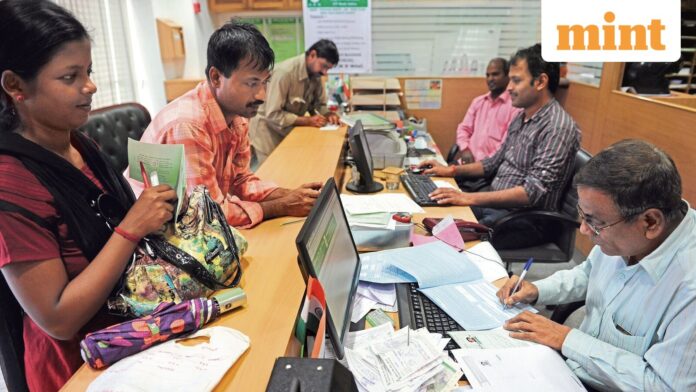Bajaj Finance, IIFL Finance, Shriram Finance and Ugro Capital are among lenders that have slowed the growth of collateral-free lending to micro, small and medium enterprises (MSME) in the September quarter. A clear shift is emerging: more secured loans, closer scrutiny of borrowers, and more cash to cover potential loan losses.
Bajaj Finance has scaled back the MSME business after gross bad loan ratio in the segment hit 2.47% in the September quarter, against 1.83% the preceding quarter and 1.65% a year earlier. India’s largest non-bank finance company (NBFC) now expects its MSME book to grow only 11-12% in FY26, sharply down from its earlier projection of nearly 20%.
“We’ve seen incipient stress across the board; it’s not regional in nature,” managing director Rajeev Jain told analysts on 10 November. “We’ve cut business by 25% and expect the worst to be behind us by March and June, after which we can be back in growth mode.”
As the MSME portfolio slows, Bajaj Finance expects its overall loan growth for the financial year at 22-23%, down from its earlier expectation of 24-25%.
“MSMEs, particularly the smaller ones, have clearly come under pressure in recent quarters. The stress is not so much linked to the tariff hike; exporters were most affected by that, and NBFC exposure there is limited. The bigger issue is over-leveraging,” Siddharth Goel, director at Fitch Ratings, said.
Many small MSMEs borrowed from multiple NBFCs during a phase when non-bank lenders were aggressively expanding credit. But when pockets of demand slowdown emerged, these NBFCs’ limited liquidity and weak capital buffers made them vulnerable, Goel said.
Unlike banks, NBFCs have heavy exposure to small enterprises with weak credit profiles; Reserve Bank of India data till the end of March shows that over 26% of NBFC loans went to small businesses with the highest credit risk. For private banks, the figure stood at 18%. This means that NBFCs are among the first to suffer when these businesses go through a rough patch.
At IIFL Finance, gross bad loans at MSMEs rose to 5.93% in the September quarter, from 5.42% a quarter ago and 3.10% a year ago. Its MSME loan book at the end of the quarter stood at ₹13,474 crore, nearly unchanged from a year earlier, but down 3% from the preceding quarter. The company attributed this to “strategic recalibration towards low-risk secured lending and pullback from unsecured lending.”
IIFL Finance maintains a “very cautious status” on MSMEs and the microfinance business, chief financial officer Kapish Jain told analysts on 31 October, adding the focus is largely on “recovery and collection.”
Credit rating agency Crisil has been sounding the alarm. In an October report, Crisil warned that bad loans in the MSME segment “may witness a cyclical inch-up, particularly in export-oriented sub-segments hit by the US tariff.”
The US has imposed a hefty 50% tariff on Indian goods, hurting production and cash flows at many export-oriented MSMEs in leather, textiles, chemicals, and gems and jewellery sectors, and impacting their ability to pay back loans.
The MSME sector accounts for more than 30% of India’s gross domestic product, and is the second-largest employer after agriculture.
At Ugro Capital, which primarily lends to MSMEs, assets under management increased by 29% annually to ₹12,226 crore. However, this was accompanied by tighter underwriting and moderated disbursals, founder and managing director Shachindra Nath told analysts on 10 November. Nath called it a “prudent approach” that aligns with the prevailing macro headwinds in the small-ticket MSME segment.
As of September-end, Ugro Capital’s gross NPA was at 2.4%, higher than 2.1% in the same period a year ago.
Ugro also said its credit cost was 2.5% of average AUM in Q2, reflecting higher provisioning to cover potential losses, even as it raises secured lending. Credit cost is the ratio of provisions and write-offs to total assets of a lender.
While MSME debt has increased, revenues haven’t kept pace especially in sectors such as textiles, leading to higher indebtedness.
Shriram Finance acknowledged increased caution in its MSME exposure, given the external risks, even as its AUM rose 16% year-on-year to ₹2.81 trillion.
Shriram Finance’s gross NPA fell to 4.57% at the end of September, from 5.32% in the same period a year ago.
“We have been cautious with the MSME segment, especially post-US tariffs, because some of the segments are dependent on the US market and some of the segments have as high as 60% of their output going into the US market, especially manufacturers and some of the service providers to them,” executive vice-chairman Umesh Revankar told analysts on 31 October.
To be sure, not all NBFCs feel the pinch equally. Ugro Capital said that fewer than 5% of its borrowers are export-oriented, keeping it relatively insulated. Yet, the broader industry does see tariff-linked stress, especially as cross-border demand cools.
Across the board, NBFCs are shifting to a “risk-first” stance to protect asset quality. Ugro, for instance, will ease off on disbursements, even as it prepares to absorb ₹3,000 crore of assets through its proposed Profectus Capital acquisition.
Shriram Finance, on its part, is closely monitoring demand, particularly in November, hoping for some easing of tariff pressures. Revankar said that any diplomatic truce could reduce risk, but emphasized that the company is not banking on that. Despite the near-term slowdown, Bajaj Finance remains confident of returning to higher growth in the segment by the first half of FY27.
Shares of Bajaj Finance, IIFL Finance, Shriram Finance and Ugro closed 0.8%, 2.6%, 0.9% and 1% higher on Monday, while the benchmark Sensex index settled 0.5% higher.
nbfc lending msme default risk,msme loan npa rise india,bajaj finance msme loan growth slowdown,iifl finance msme bad loans,shriram finance msme caution,ugro capital gross npa,collateral free lending msme india,nbfc shift secured lending msme,msme overleveraging india,fitch ratings msme credit risk,crisil msme bad loan warning,us tariff indian goods msme impact,export oriented msme stress india,credit cost nbfc india,msme sector gdp contribution india,risk first stance nbfc,msme loan growth fy26 projection,small enterprises credit risk india,nbfc exposure small business weak credit,msme textiles sector indebtedness
#NBFCs #reining #loans #MSMEs

